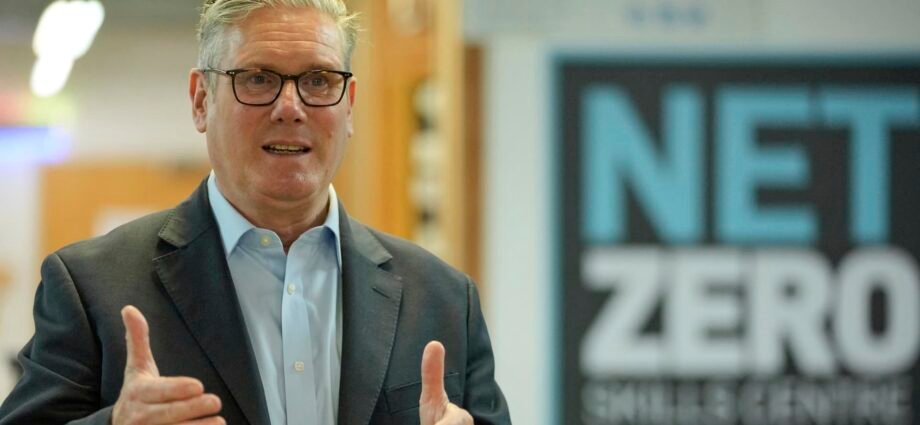European stocks decline for third day
European stocks declined for the third day in a row as investors digested earnings from some of the largest companies on the continent.
The Stoxx Europe 600 index fell by 0.5%. Regionally, Germany’s DAX declined by 1.2% and France’s CAC 40 was lower by 0.7%. Meanwhile, the U.K.’s FTSE 100 and Italy’s MIB closed flat.
— Ganesh Rao
Defense stocks sell off
German Rheinmetall MAN tactical military transport vehicles parked in the Edvard Peperko military barracks.
Luka Dakskobler | Lightrocket | Getty Images
European defense stocks are firmly in negative territory this afternoon, with the Stoxx Europe Aerospace and Defense index last seen trading 2.5% lower.
Leading the losses is Swedish defense contractor Mildef, paring earlier losses to trade 6.7% lower, and German arms manufacturer Rheinmetall, last seen trading down 3.7%.
— Chloe Taylor
European markets down
Most sectors are in the red at 11:22 a.m. in London, with risk-sensitive technology stocks down 1.4% and chemicals down 1.8%, pulling the Stoxx 600 index to a 0.57% loss.

Stoxx 600 index.
Some earnings updates are weighing on shares. French biotech firm Sartorius Stedim is down more than 10% after reporting weaker-than-expected earnings before interest and taxes (EBIT) of 128.9 million euros ($150.7 million) for the second quarter, even as year-on-year profits and revenue rose across the first half.
Swiss chocolatier Lindt and Spruengli has meanwhile lost 7% following its own miss on analyst forecasts. That’s despite the company raising its sales outlook for the year, saying it has benefitted from customer loyalty and a trend towards more premium products. The chocolate maker now sees organic sales growth of between 9% and 11%, compared to 7% to 9% previously.
Tariff uncertainty continues to hang over the investment landscape. CNBC’s Holly Ellyatt reports today on how the European Union appears to be preparing to deploy its “Anti-Coercion Instrument” — characterized as a “nuclear option” to try to deter trade disputes — in response to the White House’s 30% tariff threat.
— Jenni Reid
AstraZeneca announces $50 billion U.S. investment
AstraZeneca on Monday said it plans to invest $50 billion in bolstering its U.S. manufacturing and research capabilities by 2030, becoming the latest pharmaceutical firm to ramp up its stateside spending in the wake of U.S. trade tariffs. Read more here.

AstraZeneca share price.
Terms of Centrica’s Sizewell C stake ‘look attractive’: Jefferies
Centrica shares are still trading around 4.5% higher after the British utility firm announced it was taking a 15% equity stake and committing £1.3 billion ($1.75 billion) in construction funding to the Sizewell C nuclear plant to be built on the Suffolk coast.
Analysts at Jefferies said in a Tuesday note that the terms “look attractive” for Centrica, pointing to the company’s “robust protections against construction delays and cost overruns” and 10.8% allowed return on equity during the construction and initial operations period.
While cash yield during the construction period is forecast to be in-line with Jefferies’ own prior estimate at around 6%, Centrica’s forecast exit share of £3 billion is higher than Jefferies’ previous expectation of £2.3 billion, they said.
“We don’t expect all of it to be priced in immediately, as there is some uncertainty regarding scenarios,” the analysts wrote.
Read more about why Europe is pivoting back to nuclear — one of its most divisive energy sources — from CNBC’s Sam Meredith here.
— Jenni Reid
UK government bonds fall after government borrowing spikes
Britain’s Chancellor of the Exchequer Rachel Reeves and Britain’s Defence Secretary John Healey visit Wellington Barracks, in central London, on March 26, 2025.
Stefan Rousseau | Afp | Getty Images
U.K. government bonds, known as gilts, are selling off this morning after official data showed public borrowing rose more than expected to hit £20.7 billion ($27.9 billion) in June.
Economists polled by Reuters had been expecting borrowing to reach £16.5 billion in June.
The U.K.’s Office for National Statistics said on Tuesday that last month’s figure marked the second-highest June borrowing since records began in 1993 — after 2020, at the height of the Covid-19 pandemic.
Meanwhile, the U.K. budget deficit — the gap between spending and tax revenues — hit £16.3 billion, marking the third-highest June budget deficit since monthly records started in 1997.
Britain’s Office for Budget Responsibility said on Tuesday that despite the June spike, government borrowing remained within its forecasts.
However, the unexpectedly sharp increase in government borrowing is likely to pile additional pressure onto U.K. Finance Minister Rachel Reeves.
“Reeves will face some tough questioning on the government’s fiscal policies, following another monthly PSNB deficit that was well above expectations thanks to rising debt servicing costs,” Marc Ostwald, chief economist and global strategist at London’s ADM Investor Services, said in a Tuesday morning note.
The yield on the benchmark 10-year gilt moved 4 basis points higher by 9:07 a.m. London time (4:07 a.m. ET), to trade at 4.646%.
Bond yields and prices move in opposite directions, so government borrowing costs rise as the value of the asset goes down.
Yields on gilts across the curve rose by around 4 basis points in the wake of the ONS’ update.
— Chloe Taylor
British Gas takes 15% stake in newly-greenlit UK nuclear project with £1.3 billion investment
U.K. utility firm Centrica has announced a phased investment of £1.3 billion ($1.75 billion) into construction of Sizewell C, set to be Britain’s biggest nuclear power venture in decades after the government also on Tuesday gave final approval to the project.
Centrica shares opened more than 4% higher on Tuesday.

Centrica share price.
Final negotiations have left ownership of the project at 15% for British Gas owner Centrica, 44.9% for the British government, 20% for Canadian investment fund La Caisse, 12.5% for France’s EDF, and 7.6% for Amber Infrastructure Group.
Centrica said in a statement that the deal provided an allowed return on equity of 10.8%, and that it expected its equity share to increase to around £3 billion by the time of commercial operations in the 2030s.
The government said Tuesday that Sizewell C, along with new small modular nuclear reactors set to be built by engineering group Rolls-Royce and the delayed Hinkley Point C power plant would deliver “more new nuclear to the grid than over the previous half century combined.” U.S. private credit giant Apollo announced last month it would provide a £4.5 billion ($6 billion) loan to Hinkley Point C, which has previously faced controversy on national security grounds over high levels of Chinese funding in the plant.
Cranes surround one of the two reactors being constructed at Hinkley Point C on September 27, 2024 in Bridgwater, England.
Anna Barclay | Getty Images News | Getty Images
Earnings updates: Norsk Hydro, Julius Baer
Firms reporting this morning include Norsk Hydro, where rising aluminium and energy prices helped boost second quarter earnings.
The Norwegian renewable energy and aluminium company posted a 33% increase in core profit, which came in at 7.8 billion Norwegian kroner ($766 million), above expectations.
Lender Julius Baer meanwhile missed analyst projections for first half net profit, which fell 35% on the year to 295 million Swiss francs ($369.5 million).
The financial services group said the results reflected a previously disclosed increase in loan loss provisions, as well as a charge from the sale of its Brazilian wealth management business.
— Brittany Dawe
Here are the opening calls
Shomos Uddin | Moment | Getty Images
Good morning from London, and welcome to CNBC’s live blog covering all the action and business news in European financial markets on Tuesday.
Futures data from IG suggest a negative start to the new trading week for European bourses, with London’s FTSE 100 seen opening 0.3% lower, France’s CAC 40 down 0.3%, Germany’s DAX down 0.4%, and Italy’s FTSE MIB 0.4% lower.
European bourses have been on edge since U.S. President Donald Trump announced earlier in July that he would impose a 30% tariff on goods imported from the EU starting Aug. 1. The EU said it hopes to strike a trade deal before then but an agreement remains elusive. The bloc’s policymakers are reportedly considering retaliatory measures if a deal can’t be reached.
U.S. Treasury Secretary Scott Bessent said Monday that implementing high tariff rates on countries starting Aug. 1 “will put more pressure on those countries to come with better agreements.”
— Holly Ellyatt
Global market action overnight
Traders work on the floor at the New York Stock Exchange in New York City, U.S., July 21, 2025.
Brendan McDermid | Reuters
U.S. stock futures were little changed early Tuesday after the S&P 500 and Nasdaq Composite hit fresh records in Monday’s trading session.
The S&P 500 rose about 0.1% and the Nasdaq Composite advanced nearly 0.4% yesterday, with both indexes hitting new all-time intraday highs and closing at records, aided by a pre-earnings jump in Alphabet. The Dow underperformed and ended the day marginally lower.
Meanwhile, Asia-Pacific stocks traded mixed overnight, with Japanese stocks reopening higher after the ruling coalition lost its majority in the upper house over the weekend.
— Holly Ellyatt


